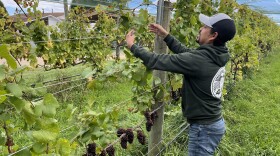-
A federal ban on most hemp-derived THC products is expected to go into effect in November. It could eliminate the most profitable market for farmers who grow hemp.
-
Michigan produced over 44 million bushels of soft winter wheat in 2025, the second highest yield in the nation.
-
Most of the package is earmarked for row-crop producers. It aims to help farmers – especially those who grow soybeans – balance out losses from high costs and a trade war with China.
-
Some tree farms in the central U.S. are selling more potted Christmas trees as people seek out an eco-friendly option or look to get more than one use out of their evergreens.
-
The pumpkin pie Americans enjoy each Thanksgiving often comes from pumpkins grown near Morton, Illinois. The region accounts for more than 95% of canned pumpkin in the U.S.
-
Michigan's Indigenous communities harvest wild rice, or manoomin, every year as part of their cultural heritage and modern-day work to restore the plant.
-
Federal food assistance has started to flow again after the government reopened. But the charitable food system is planning for continued need through the end of the year.
-
Congress extends critical Farm Bill for a third time. It's a relief for farmers, but raises concernsThe federal funding package to reopen the government included a one-year extension of certain 2018 Farm Bill programs. Several expired Sept. 30 or would have been null by the end of the year.
-
Researchers at Michigan State University are working to create an outdoor lab that monitors the effects of solar arrays on farms and their crops across the state. The goal of the project is to use solar energy to improve agricultural production.
-
The decision comes after years of outcry from some farmers that the cost of labor, transportation and housing for H-2A workers was making it impossible to break even.
Play Live Radio
Next Up:
0:00
0:00
Available On Air Stations










